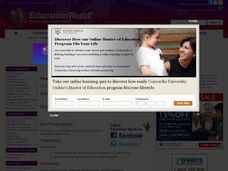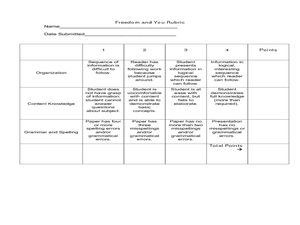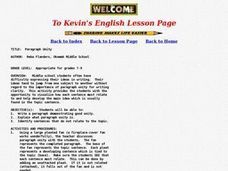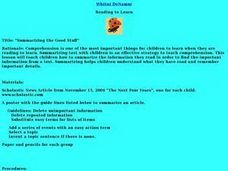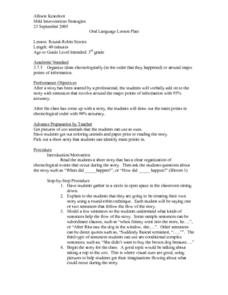Education World
Take Five: Writing a Color-Coded Paragraph
Use a traffic light to model a very basic paragraph plan. The Go, or topic sentence, is written in green and expresses an opinion about the topic. Information that supports the opinion of the Go sentence is written in yellow and the...
Curated OER
Developing a Topic for Writing Using an Idea Web
Teach your upper graders how to use an idea web to develop a topic for writing. After reading a variety of stories about friendship (a list of stories with the theme of friendship is included), model using an idea web. Class members...
Curated OER
Stepping in: Good Samaritan or Fool?
Pupils write an opinion piece, including facts of this situation and any other statistics about helping others during a fight. Students offer suggestions about how to break up a fight, or when not to try (based on what national experts...
Curated OER
Animation Pre-Production
Does your class love reading cartoons? Use their talents and interests to examine the process of writing a story they wish to tell through a cartoon. They develop the beginning, middle, and end of a story based on their original...
Curated OER
Main Idea and Supporting Details
Second graders write topic sentences. In this writing lesson, 2nd graders construct a paragraph consisting of a topic sentence and 2-4 additional sentences. Students analyze their writing and publish a final copy.
Scholastic
What’s the Good Word? Etymology Project Guidelines
Who named the shapes, or the days of the week? Should words be removed from the dictionary if they're no longer commonly used? Are there too many words in the English language? Language arts students explore these and additional...
Curated OER
Slim Down to the Good Stuff by Summarizing
Students summarize a piece of literature using the technique "mapping" in this lesson plan. The technique involves 6 main steps: delete unimportant information, delete repeated information, substitute easy terms, add a series of event...
Curated OER
Language Arts: Writing Skills Development
Young scholars improve writing skills by expanding their self-perceptions. Next, they develop idea lists for writing topics. Their ideas become the basis for a class newspaper. following the creation of a group composition, students...
ProCon
President Ronald Reagan
At 69 years old, Ronald Reagan was the oldest man ever to be elected president in the United States. After reviewing a thorough history of Reagan's presidency, pupils read the main pro and con arguments to determine if he was a good...
Curated OER
Writing - Combining Ideas to Write Descriptive Paragraphs
Pupils develop a strategy for combining various ideas into well formed sentences which then combine to produce effective descriptive paragraphs.
Curated OER
Picture This
Elementary writers practice writing descriptive paragraphs by adding adjectives and sensory words to their writing. They use a picture of a monster for their descriptive paragraph. This 12-page lesson should increase your charges...
Curated OER
Hot Dog Writing
Use a hot dog as a metaphor for good reading, and make your class drool! Writers identify the parts of a paragraph, linking them to parts of a hot dog. Then, they translate this knowledge into a well-written paragraph. While a check-list...
Teacher Web
1920's Magazine
What a creative and engaging project to incorporate into your studies of the 1920s! Your young historians will work in groups to design a magazine discussing the political and cultural topics of the decade, each member writing one...
Curated OER
Descriptive Paragraphs
Third graders gain the necessary skills to write a descriptive paragraph. They see the evaluation and decision making process that are used in good wriitng. The bible is used to see illustrations and then used to paint a picture in...
Curated OER
How to Research and Write an Essay
Research and write a 500-word essay. Pupils research a topic and write an essay based on their research. They use the given directions and examples to help them research, organize, format, and write their essay. There's a short chart...
Curated OER
Just Get to the Good Part
Learners summarize nonfiction text. After reviewing the steps for summarization, students independently read a nonfiction article. They write a summary paragraph using the six-step process outlined by the instructor during guided practice.
Curated OER
Freedom and You
Students research the American Revolution. In this Revolutionary War activity, students research facts about the American Revolution, write an expository essay, and peer edit for good content. The paper is suggested to be written after...
Curated OER
Swoosh-Remember That
Students use a six step process to write a summary of a provided paragraph. The steps include: delete unimportant information, delete repeated information, substitute easy terms for a list of items, add a series of events with an easy...
Curated OER
Reading And Summarizing in Science
Students read articles about various scientific topics from a variety of science disciplines and a variety of sources including newspapers, the internet, scientific journals and magazines for students. They review the articles...
Curated OER
Paragraph Unity
Young scholars explore how to develop a complete paragraph using a piece of paper folded into a large fan. They SEE how each sentence relates to the topic.
Curated OER
Summarizing the Good Stuff
Students summarize a selected piece of text nonfiction text. After reviewing the correct way to read silently, students read a nonfiction article. Working in groups, they write a summary paragraph using the five step process outlined by...
Curated OER
Brainstorming Research Questions
Young scholars examine and participate in an inquiry process. They brainstorm recall, comprehension, and synthesis questions for a research topic, and write the questions on sentence strips.
Curated OER
La Mochila (The Backpack)
Students examine objects, labeled in Spanish, that are common items found in a backpack. They write simple sentences in Spanish listing the items from the backpack.
Curated OER
RoundRobin
Third graders, following an original start to a new story, verbally add on to the story with sentences that revolve around the major points of information. After the students come up with a story, they draw out the main points in the...











